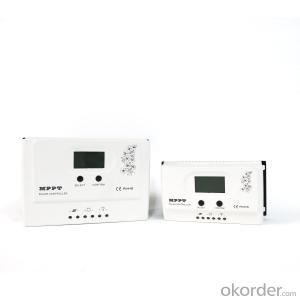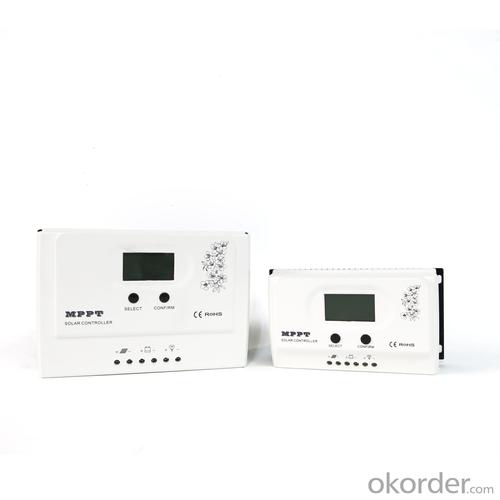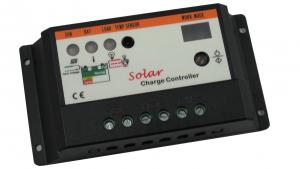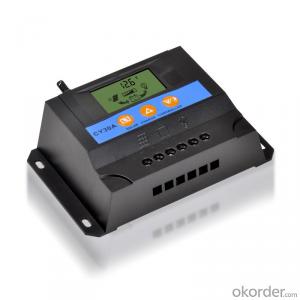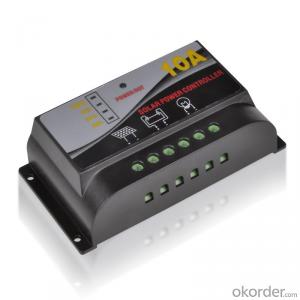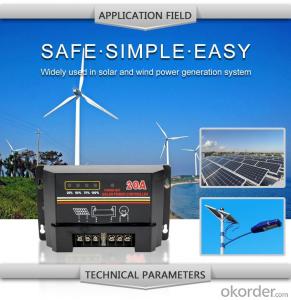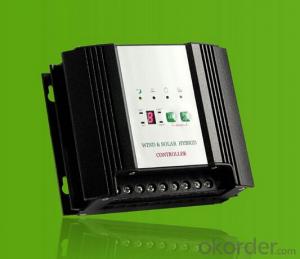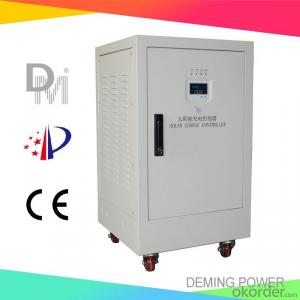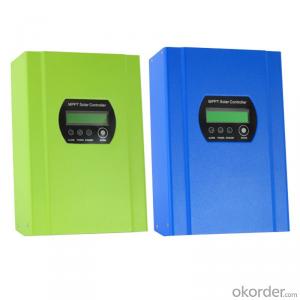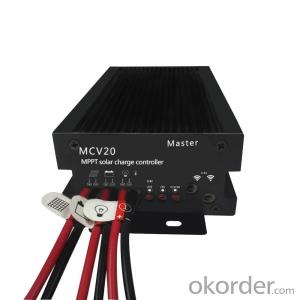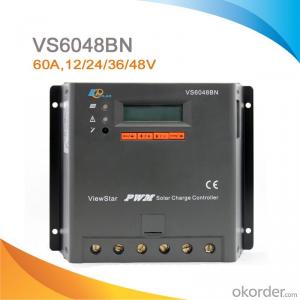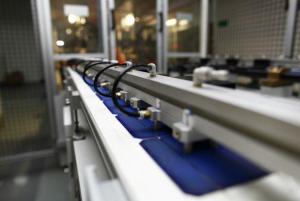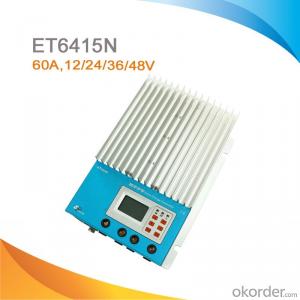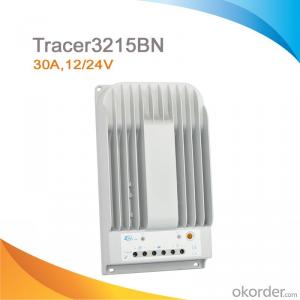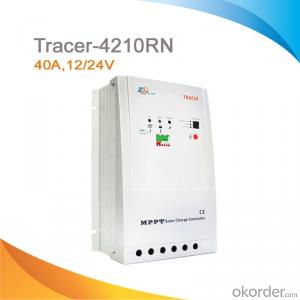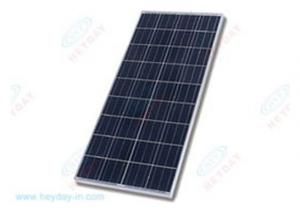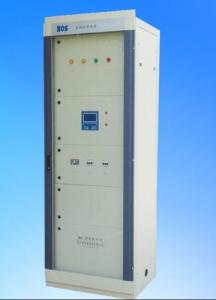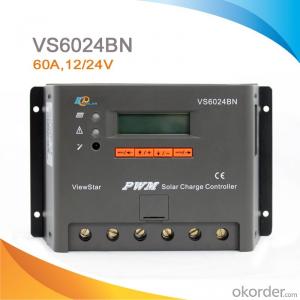Plasmatronics Solar Controllers - Max. PV Input 100V Solar Charge 12V/24V Controller 15A MPPT with LCD
- Loading Port:
- China main port
- Payment Terms:
- TT OR LC
- Min Order Qty:
- 20 unit
- Supply Capability:
- 9999 unit/month
OKorder Service Pledge
OKorder Financial Service
You Might Also Like
Max. PV Input 150V Solar Charge 12V/24V Controller 15A 20A 30A 40A 50A MPPT with LCD
I-P-Wiser 1 series adopted with auto cool, high conversion efficiency, LCD display and free PC software. It features an efficient MPPT control algorithm to track the maximum power point of the PV array in any environment. Greatly improve the utilization of solar panel. Also added the output function(USB 5V 3A). For the mppt controller can be widely used in off-grid solar system, Communication base station solar system, household solar systems, street light solar systems, field monitoring and other fields.
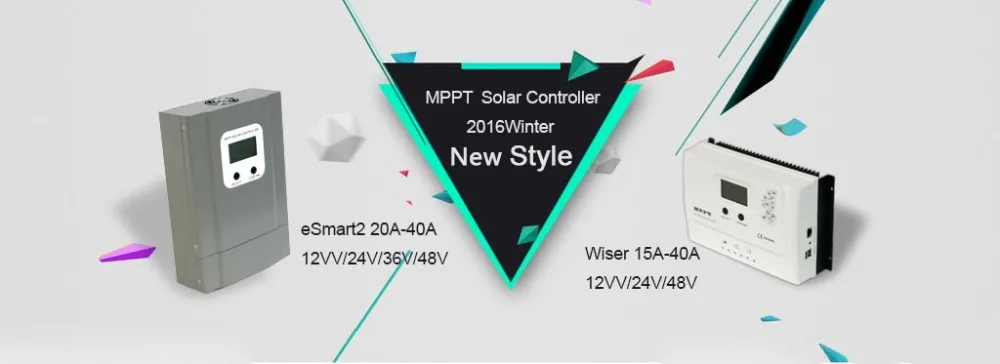
| Product Show |
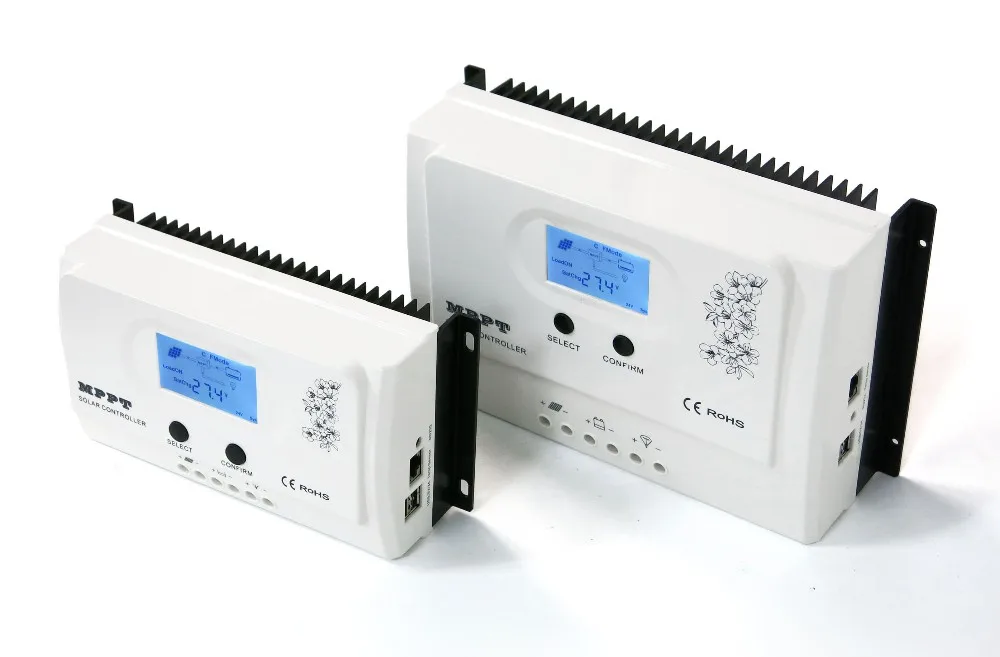
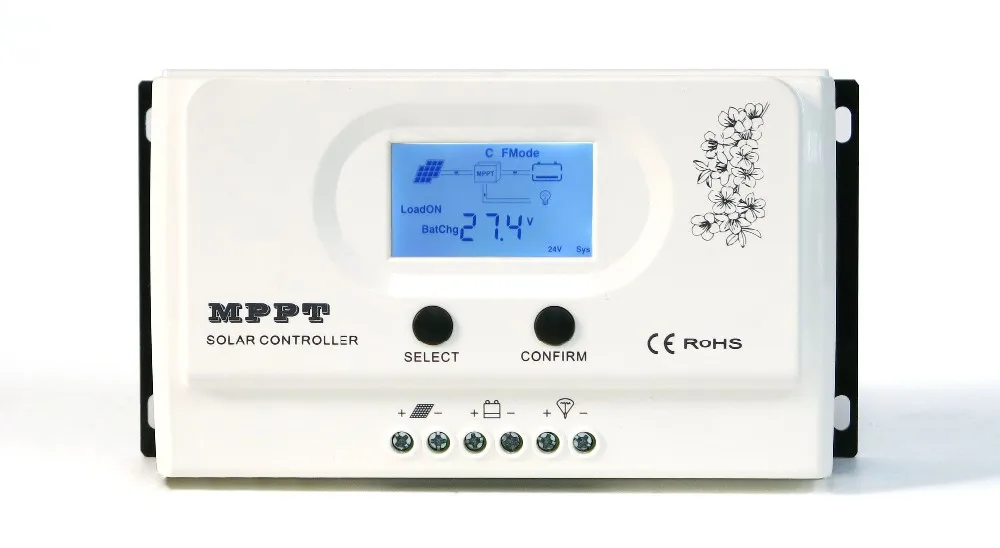
| MPPT Controller connection diagram |
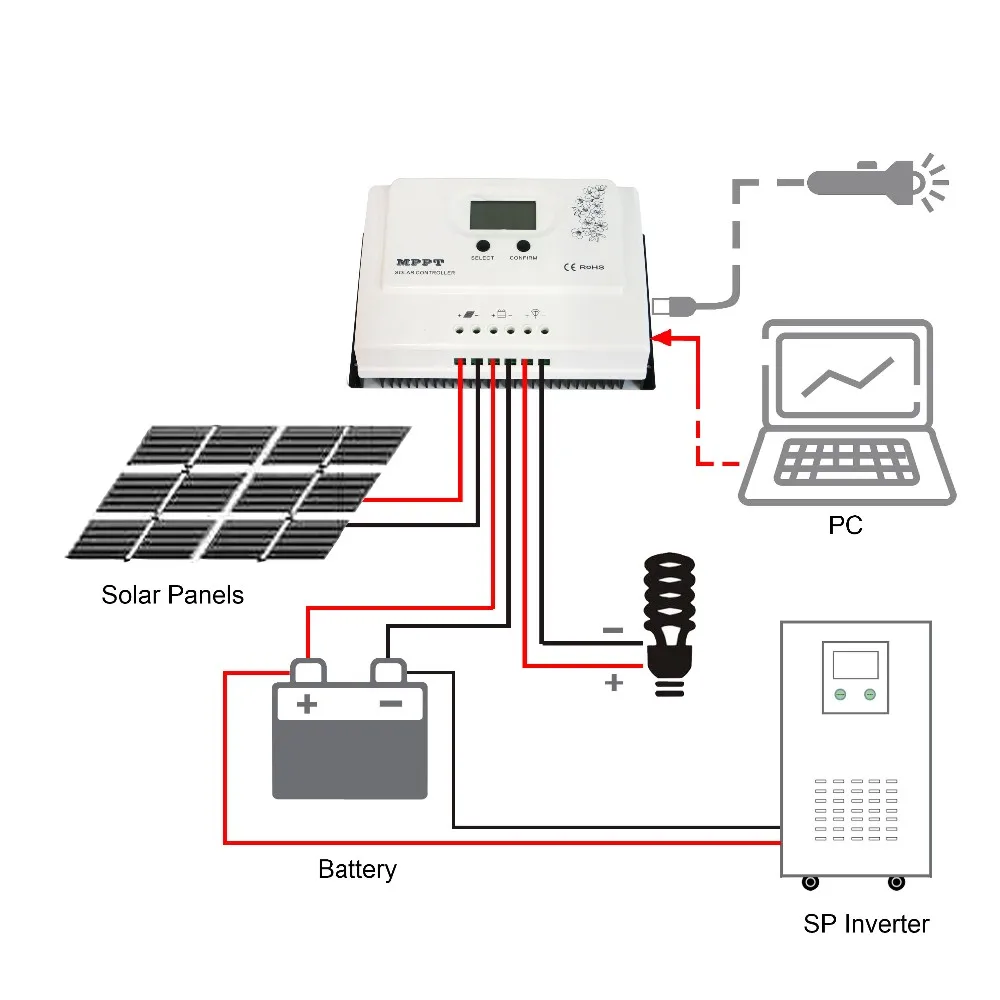
| Features |
1.High efficiency MPPT control algorithm, MPPT efficiency ≥99.5%, whole Machine conversion efficiency upto 98%;
2.12V/24V system Automatic Recognition,users can use it in different system conveniently.
3.Maximum PV input voltage: 100VDC(15A, 20A), 150VDC (30A, 40A,50A)
4.Charge mode: three stages (fast charge, constant charge, floating charge). It prolongs service life of the batteries.
5.Discharge mode: ON/OFF mode, PV voltage control mode.
6.Recommended battery types: sealed lead acid, vented, gel, NiCd battery. Other types of the batteries can also be defined.
7.Most information could be provided by LCD like: system type., PV input voltage, battery type, battery voltage, charging current, charging power, working status and so on. Also customer's information like company name, website and logo can be added into Solar Eagle software.
8.RS232 communication, we can offer communication protocol also, it’s convenient for user’s integration management.
9.CE, RoHS, FCC certifications approved.. We can help clients to approve other certifications.
10.2 years warranty. And 3~10 years extended warranty service also can be provided.
Upper Computer Software and Test Software |
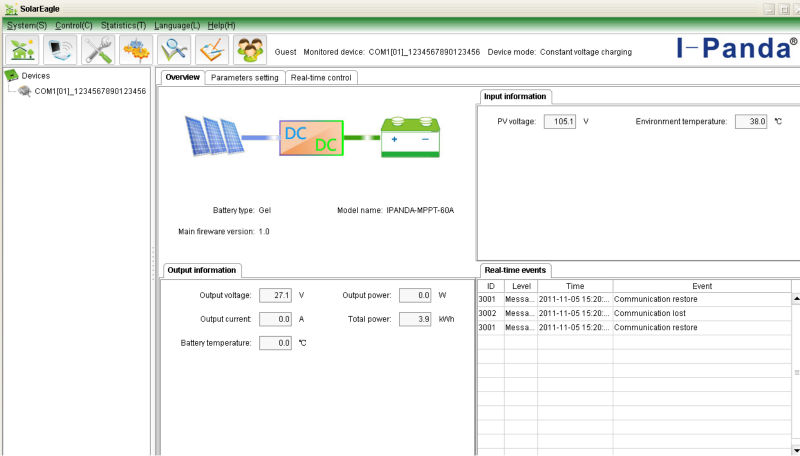
PC software_SolarEagle
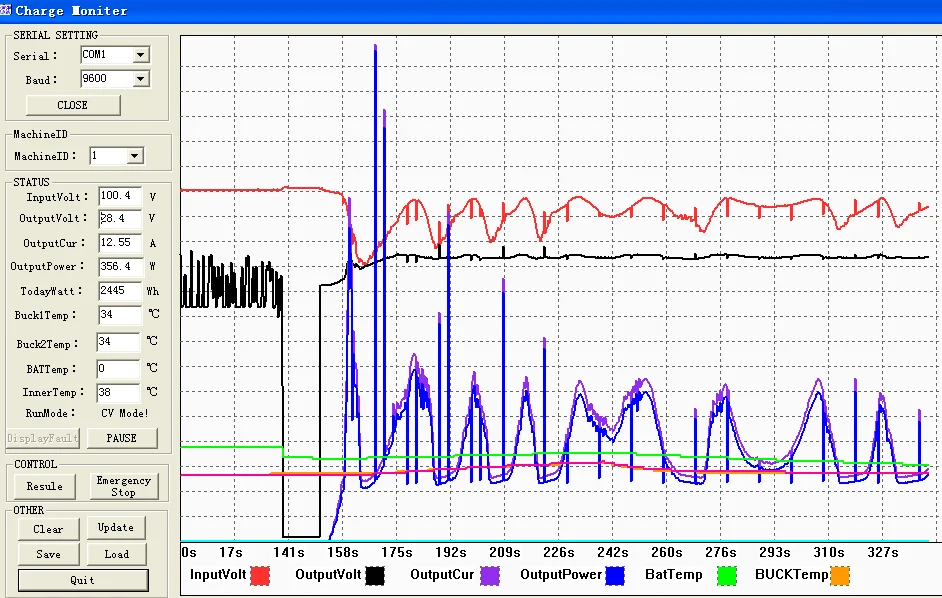
Monitoring software
Visual display of charge and discharge status, PV voltage, charge voltage, charge current, and can set the battery type, LOAD output control;
parameters |
Model: | 15A | 20A | 30A | 40A | 50A | |
I-P-Wiser 1-12V/24V-Series | ||||||
Charge mode | MPPT(maximum power point tracking) | |||||
MPPT efficiency | ≥99.5% | |||||
System type | DC12V/24V system | Automatic Recognition | ||||
INPUT CHARACTERISTICS | ||||||
PV Max PV input voltage(VOC) | 12V/24V system | DC100V | DC150V | |||
Start the charging voltage point | 12V system | 18V | ||||
24V system | 32V | |||||
High input voltage protection point | 12V/24V system | DC100V | DC150V | |||
High input voltage recovery point | 12V/24V system | DC95V | DC145V | |||
Rated PV power | 12V system | 200W | 260W | 390W | 520W | 650W |
24V system | 400W | 520W | 780W | 1040W | 1300W | |
CHARGE CHRECTRESTICS | ||||||
Selectable Battery Types | 12V/24V system | Sealed lead-acid batteries, Vented batteries Gel, NiCd battery (Other types of the batteries also can be defined) | ||||
Charge method | 12V/24V system | Three stages charge: constant current(MPPT), constant voltage, floating charge | ||||
Charge rated current | 12V/24V system | 15A | 20A | 30A | 40A | 50A |
OUTPUT DISCHARGE CHARACTERISTICS | ||||||
USB (Total for 2 USB output) | DC5V 3A | |||||
LOAD output voltage | Based on battery voltage | |||||
Max. DC Load current | 30A | |||||
Output control mode | ON/OFF mode, PV voltage control mode | |||||
Output control set way | Controller button or PC software | |||||
DISPLAY | ||||||
LCD Display | System type, PV voltage,charge voltage, charging current, charging power, temperature etc. | |||||
PC software | RS232 | |||||
OTHER PARAMETERS | ||||||
Protection function | Yes (Over voltage, low voltage, over temperature, over load, Short circuit protection etc.) | |||||
Cooling mode | Auto cool | |||||
Type of Mechanical Protection | IP 30 | |||||
Measurement DxWxH (mm) | 200*110*66 | 243*155*79 | ||||
Packing DxWxH (mm) | 249*144*105 | 289*189*113 | ||||
N.W. (KG) | 0.9 | 1.8 | ||||
G.W. (KG) | 1.3 | 2.2 | ||||
Certifications |
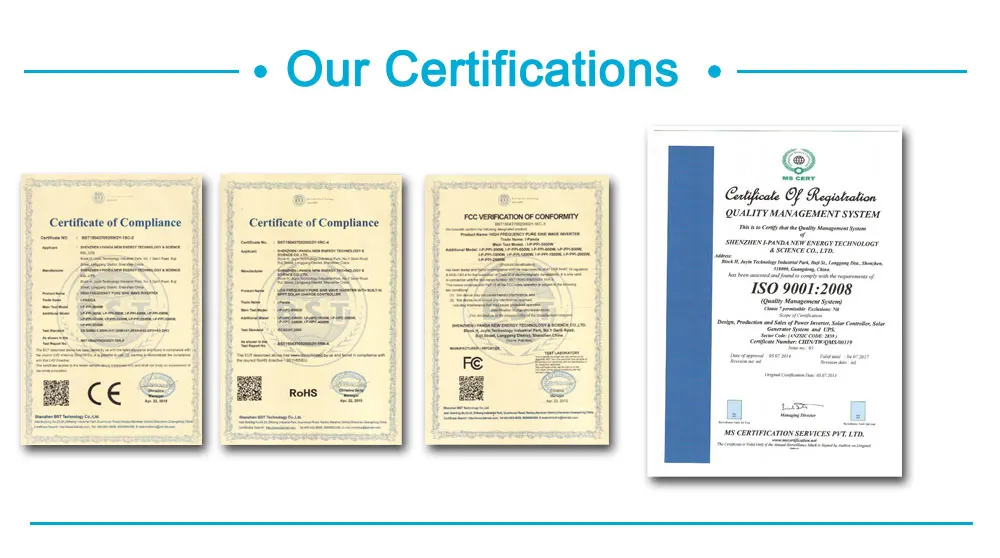
F&Q: |
Q1. How to ensure and monitor the products quality?
A1: We have established a perfect Quality Management System, In strict
accordance with ISO9001: 2008 quality system and ISO14001 environment system for quality assurance management;
Our ISO9001:2008 Quality System certificate encoding: CHIN/TW/QMS/00119;
Our ISO14001 Environment System certificate encoding: CHIN/TW/EMS/00028;
Q2. What is the warranty of products?
A2: The warranty period of different products are different; 5 years, 3 years, 2 years, 1 years; More details please refer to the product specification or manual; we will provide free life-long technical support ;
Q3. What is the difference between MPPT&PWM?
A3. MPPT charging mode, peak efficiency up to 99%, saving 30%~60% solar panel than traditional PWM controller.
- Q: Can a solar controller be used with different types of solar panel cleaning systems?
- Yes, a solar controller can be used with different types of solar panel cleaning systems. A solar controller is designed to regulate and optimize the charging and discharging of batteries in a solar power system. It helps regulate the flow of electricity from the solar panels to the batteries, ensuring that they are charged efficiently and safely. The type of solar panel cleaning system used does not directly affect the functioning of the solar controller. The controller's main purpose is to manage the flow of electricity, and it does not have any specific compatibility requirements with different cleaning systems. However, it is important to note that the solar controller should be compatible with the overall solar power system and the specific cleaning system being used. This means that the controller should be able to handle the voltage and current requirements of the solar panels and the cleaning system. It is recommended to consult the manufacturer's specifications and guidelines to ensure that the solar controller is suitable for the specific cleaning system being used.
- Q: How does a solar controller handle battery equalization charging?
- A solar controller handles battery equalization charging by monitoring the voltage levels of each individual battery in a battery bank. When the controller detects that the voltage of one or more batteries is significantly lower than the others, it activates the equalization charging mode. During this mode, the solar controller applies a higher voltage to the battery bank, typically around 15 volts, to bring the lower voltage batteries up to the same level as the rest. This process helps to ensure that all batteries in the bank receive an equal charge, maximizing their performance and longevity.
- Q: How does a solar controller handle variations in solar irradiation levels?
- A solar controller handles variations in solar irradiation levels by continuously monitoring the incoming solar energy and adjusting the charging parameters accordingly. It uses a sophisticated algorithm to optimize the charging process and ensure maximum efficiency regardless of the changing solar conditions.
- Q: What is the purpose of the battery overcharge protection feature on a solar controller?
- The purpose of the battery overcharge protection feature on a solar controller is to prevent the batteries from getting damaged due to overcharging. Solar panels generate electricity from the sun, and this electricity is stored in batteries for later use. However, if the batteries are continuously charged beyond their capacity, they can become overcharged, which can lead to several issues. Overcharging a battery can cause it to heat up, which can result in the degradation of the battery's internal components, reducing its overall lifespan. It can also cause the battery to release harmful gases, such as hydrogen, which can be dangerous and potentially lead to explosions or fires. To avoid these risks, solar controllers with battery overcharge protection feature are designed to monitor the charging status of the batteries. When the batteries reach their full capacity, the controller automatically detects this and stops the flow of electricity from the solar panels to the batteries, preventing any further charging. This helps to maintain the batteries at their optimal charge level, ensuring their longevity and safe operation. Furthermore, the battery overcharge protection feature also helps to maximize the efficiency of the solar system. By preventing overcharging, the controller ensures that the excess energy generated by the solar panels is not wasted and instead can be used efficiently when required. In summary, the purpose of the battery overcharge protection feature on a solar controller is to safeguard the batteries from potential damage caused by overcharging, extend their lifespan, and enhance the overall efficiency of the solar system.
- Q: Can a solar controller be used with a solar-powered internet connection?
- Yes, a solar controller can be used with a solar-powered internet connection. A solar controller regulates the charging and discharging of batteries in a solar power system, ensuring optimal performance and longer battery life. It can be employed in a solar-powered internet setup to manage the charging of batteries that store excess solar energy for powering internet equipment, ensuring a reliable and sustainable internet connection.
- Q: What is the maximum temperature rating for a solar controller?
- The maximum temperature rating for a solar controller typically varies depending on the specific model and manufacturer. However, most solar controllers are designed to operate within a temperature range of -10°C to 60°C (14°F to 140°F).
- Q: Can a solar controller be used with a solar-powered university or college?
- Yes, a solar controller can be used with a solar-powered university or college. A solar controller is an essential component of a solar power system as it regulates the flow of electricity from the solar panels to the batteries. This ensures that the batteries are charged efficiently and protected from overcharging or damage. In a solar-powered university or college, a solar controller would be necessary to optimize the performance of the solar panels and store excess energy for later use, contributing to the institution's sustainable energy goals.
- Q: How do I prevent undercharging of batteries with a solar controller?
- To prevent undercharging of batteries with a solar controller, you can follow a few key steps: 1. Ensure proper battery sizing: Make sure your solar controller is compatible with the battery capacity and voltage you are using. Undersized controllers may not be able to properly charge the batteries. 2. Optimize solar panel capacity: Ensure that your solar panel capacity is sufficient to meet the charging needs of your batteries. If the solar panel capacity is too low, it might not generate enough energy to fully charge the batteries. 3. Set appropriate charging parameters: Adjust the charging parameters on your solar controller according to the battery manufacturer's recommendations. This includes setting the correct charging voltage, absorption time, and float voltage, which will help prevent undercharging. 4. Monitor battery status: Regularly monitor the battery status using a battery monitor or built-in controller features. This will help you identify any potential issues with undercharging and take corrective actions promptly. 5. Implement proper maintenance: Perform regular battery maintenance, including checking for any signs of sulfation or corrosion, and cleaning the battery terminals. A well-maintained battery will be more efficient and less prone to undercharging. By following these steps, you can ensure that your solar controller charges your batteries optimally, preventing undercharging and maximizing their lifespan and performance.
- Q: How do I determine the maximum solar panel input voltage for a solar controller?
- In order to determine the maximum input voltage for a solar controller, one must take into account the specifications of both the solar controller and the solar panels being used. Firstly, it is necessary to consult the datasheet or user manual of the solar controller and locate the maximum input voltage rating provided in the specifications section. This rating signifies the highest voltage that the controller can safely handle without causing any harm or malfunctions. It is imperative to ensure that the voltage of the solar panels does not surpass this maximum input voltage rating. Following that, the open circuit voltage (Voc) of the solar panels must be determined. This refers to the voltage generated by the panels when no load is connected. Typically, this information can be found on the datasheet or product specification of the solar panels. The open circuit voltage of the solar panels should then be compared with the maximum input voltage rating of the solar controller. If the voltage of the solar panels is equal to or below the maximum input voltage rating of the controller, it means that the solar controller can safely handle the panels. However, if the voltage of the solar panels exceeds the maximum input voltage rating of the solar controller, there are a few options available. One option is to utilize a step-down voltage converter or a voltage regulator to reduce the panel voltage to a level that falls within the range supported by the controller. Another option is to consider using a different solar controller with a higher maximum input voltage rating that is capable of handling the voltage of the solar panels. Ultimately, it is crucial to ensure that the voltage of the solar panels falls within the specified limits of the solar controller in order to prevent any damage to the controller and to ensure the optimal performance of the solar power system.
- Q: How do you prevent short-circuiting of solar panels with a solar controller?
- You can prevent short-circuiting of solar panels with a solar controller by properly sizing the controller to match the panel's voltage and current rating. Additionally, the controller should have built-in protection features such as overcurrent and overvoltage protection, as well as short-circuit protection. These protective mechanisms ensure that any potential short-circuits or electrical faults are detected and the controller automatically shuts off the current flow to prevent damage to the solar panels.
Send your message to us
Plasmatronics Solar Controllers - Max. PV Input 100V Solar Charge 12V/24V Controller 15A MPPT with LCD
- Loading Port:
- China main port
- Payment Terms:
- TT OR LC
- Min Order Qty:
- 20 unit
- Supply Capability:
- 9999 unit/month
OKorder Service Pledge
OKorder Financial Service
Similar products
Hot products
Hot Searches
Related keywords
